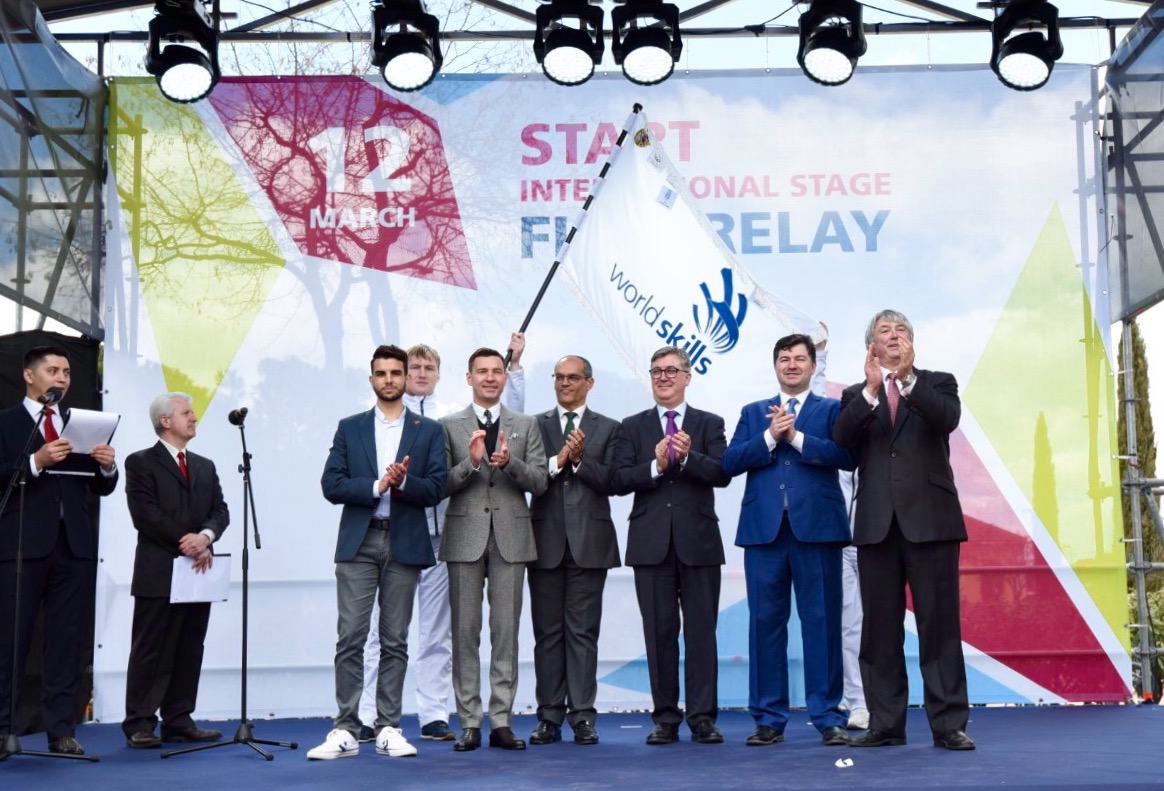7 August 2018
20 stops celebrating 44 WorldSkills Competitions
Two months later after its trip to space, and back on Earth, the flag began its international journey in Madrid this March, in the city where the WorldSkills story began in 1950.

Two months later after its trip to space, and back on Earth, the Flag began its international journey in Madrid this March, in the city where the WorldSkills story began in 1950.
It was in the Spanish capital where barely a dozen Competitors took part in the first competition, that the WorldSkills movement was launched. There are now an astonishing 79 Member countries and regions embracing the life-changing message of vocational skills and training for the young people of the world.
For the first part of the relay, the Flag has been on a journey to mark every previous WorldSkills Competition, a total of 44 to date.
It was sent on its way at the Institute Virgen de la Paloma, the site of that first Competition, watched by the current generation of students and some of those who took part more than 60 years ago.
For the last six months, the Flag Relay has been journeying through past WorldSkills Competitions, preserving the past to create a new tradition, but also reaching out with a strong message for today’s young people and prospective employers of the value of vocational skills for a thriving economy and a prosperous future.
The 100,000 kilometre journey though 21 countries and regions on five continents is a powerful reminder of the rich history of WorldSkills and the sheer scale of its reach, now calculated in the billions.
Like the Competition, the Flag Relay started in Europe, moving from Madrid to Barcelona then to Duisberg, to mark the three German events, including Munich in 1973 and Leipzig 2013.
At each stage, embroidered patches from each country’s Competitions were added to the Flag as a permanent reminder.
From Zwolle and the Closing Ceremony of the WorldSkills Netherlands National Competition, the Flag Relay took to the skies and a transatlantic crossing on 24 March to Atlanta, in the United States which was the host city in 1981 and the first time the contest was held in North America.
April saw Korea first on the itinerary, to mark Busan 1978 and Seoul in 2001. Then it was 7,000 kilometres back to Abu Dhabi, where the first Competition to be held in the Middle East was marked at the closing of the EmiratesSkills National Competition.
May brought the Flag Relay to Sines to commemorate Lisbon in 1964 but also as a reminder that Portuguese young people were among those first pioneering Competitors in the early days. On 14 May it reached Tampere in Finland, the host country for Helsinki in 2015.
Paris, Dublin, and St Gallen in Switzerland completed this next leg of the European tour before a 16,500 kilometre trip to Sydney, Australia that ended on 1 June.
Edmonton and the Skills Canada National Competition recalled Montreal 1999 and WorldSkills Calgary 2009, and added another 13,000 kilometres. By the time the Flag Relay returned to Europe and Selva di Val Gardena to mark Modena 1958, it had completely circled the world.
July began in Brussels. Then it was the turn of Swansea in Wales with patches added for the Competitions in Glasgow in 1965, Birmingham in 1989 and London in 2011.
On July 6, the Relay traveled to Lachstatt in Austria for Linz in 1983 and then on to Brazilia, the capital of Brazil in recognition of WorldSkills São Paulo 2015, where Kazan was selected to host the 45th WorldSkills Competition in 2019.
The international leg of the relay concluded in Kanazana in Japan, as a reminder of Osaka in 1985 and Shizuoka in 2007, before and finally travelling to Taichung City in Chinese Taipei, hosted in 1993, on 6 August.
The final stage will cross Russia, the home of the host country, ending after 500 days on the road in Kazan for August 2019. And with 85 stops still to go over the next 12 months, the relay shows no sign of flagging.